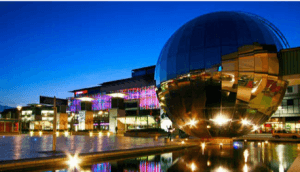The Internet of Things is an elusive, vague, and “futuristic” term; it’s a term that many, even prominent technical developers, have trouble understanding.
Fortunately for all of us, this is what Srikanth Mangalam, an internationally recognized expert in public policy and sustainable development, sought to demystify at his talk for the Hunt Institute’s T3 Series in January. He opened by defining the Internet of Things, or IoTs for short, according to a report he co-authored for the World Bank in which he said, “IoTs refers to a system of connected devices or sensors that gather data, connect with the Internet or local networks, and generate analytics.” He then showed a video describing the methodology behind Amazon Go, a “smart” grocery store where no check-out clerks or cashiers are needed because the carts and baskets automatically detect what is inside them and charge customers accordingly. Mangalam used this fairly simple example to emphasize that IoTs are already prevalent around us in our phones, cars, and public infrastructure.
Mangalam further discussed how IoTs can enhance our existing technological capabilities by improving the speed of data collection and, therefore, response time. Notably, he cited the example of the “Damp Busters” pilot project which designed and developed a frog-shaped sensor to detect moisture and temperature inside buildings. This innovation had important implications for low cost housing options, making them healthier, safer, and in the long run, more affordable. This project is one of many that illustrates the benefit potential of IoTs.
Mangalam then transitioned to speaking on broader implementations of IoTs and brought up an example from the United Kingdom as a blue-print for what successful and widespread IoT adoption should look like. Bristol University and the Bristol City Council have teamed up to form “Bristol’s Data Dome” – an initiative that connects various agencies to develop and pilot IoT projects targeted to meet specific goals. The key takeaway from this example was transparency. In this Bristol initiative, local/national government, companies, NGOs, and private citizens were all involved and connected by free and open access to the data. Because of this, project plans could include a broad range of perspectives and inputs and were able to more acutely address local needs. Additionally, Bristol’s open IoT network allows for experiments to be deployed on a city-wide scale and tweaked, if necessary, in real time. Mangalam noted that this aspect of the “Data Dome” has become critical for Bristol lawmakers. Now, potential policy changes can be tested on the ground before being set in stone.

There is still much to be discovered about IoTs. One thing Mangalam is sure of, however, is the importance of governments in catalyzing IoT research, innovation, and successful implementation. He referenced a report that he co-authored for the World Bank which outlines a few pillars that, if upheld, could maximize the potential of IoTs. The first pillar deals with leadership measures and explains that governments must proactively develop both regulations and standards concerning IoT. Next, the report discusses IoT “strategy” which should involve sandboxes to test experiments, public-private partnerships, local businesses, and more. Essentially, increased collaboration on IoT projects for social/economic good will likely result in more success. Finally, the third pillar is engagement. Governments seeking to advance IoT deployments should educate and build awareness amongst all stakeholders affected by or integral to a project’s success.

